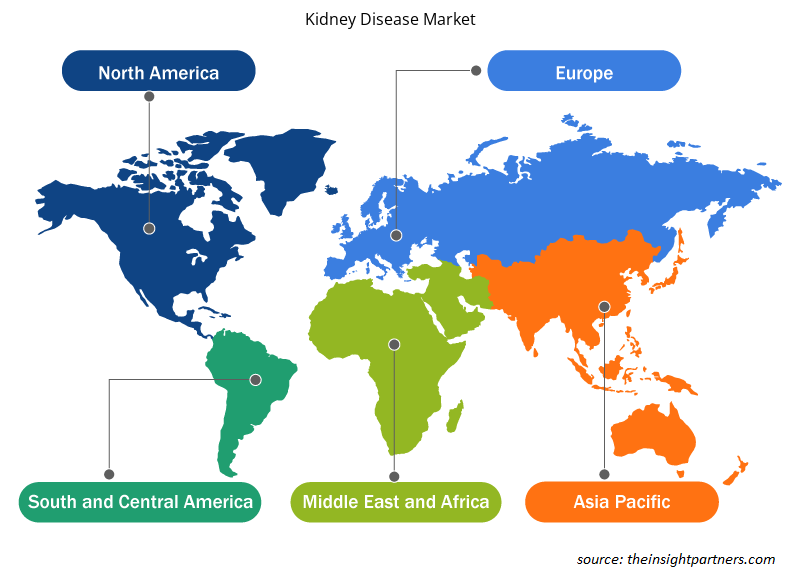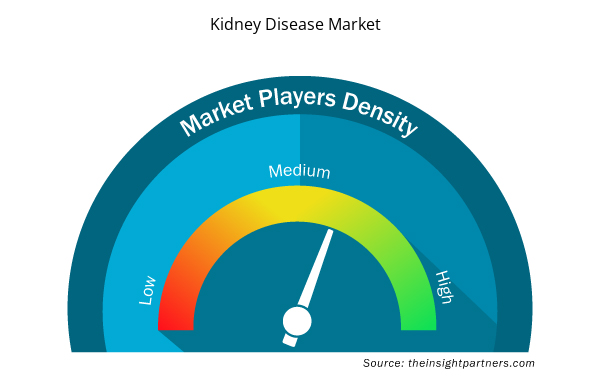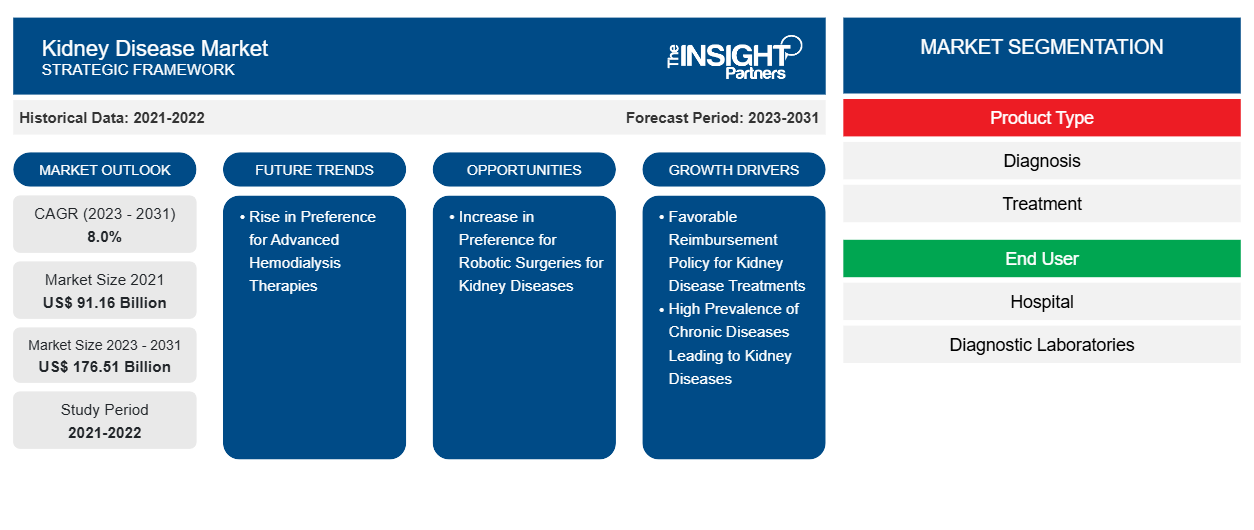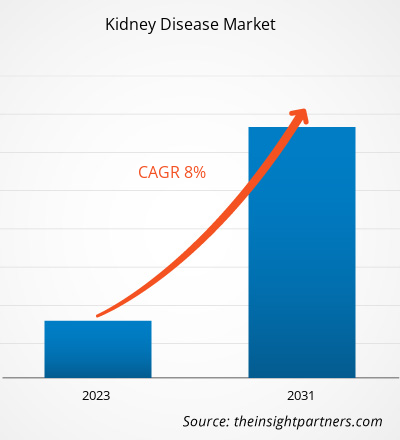Das Marktvolumen im Bereich Nierenerkrankungen wurde im Jahr 2021 auf 91,16 Milliarden US-Dollar und im Jahr 2023 auf XX Milliarden US-Dollar geschätzt und soll bis 2031 176,51 Milliarden US-Dollar erreichen; für den Zeitraum 2023–2031 wird eine durchschnittliche jährliche Wachstumsrate (CAGR) von 8,0 % erwartet.
Neue, verbraucherorientierte und sicherheitsbewusste Produkte sind durch die steigende Prävalenz von Nierenerkrankungen motiviert, und immer mehr geriatrische Patienten sind bereit, für die Behandlung zu Hause zu bleiben. Solche fortschrittlichen therapeutischen Alternativen werden wahrscheinlich weiterhin wichtige Markttrends für Nierenerkrankungen bleiben.
Marktanalyse für Nierenerkrankungen
Chronische Nierenerkrankung (CKD) ist eine häufige und lebensbedrohliche Erkrankung, die weltweit 1 von 10 Menschen betrifft. Hoher Blutdruck und Diabetes sind für zwei Drittel aller Fälle von CKD verantwortlich. Darüber hinaus würden laut einer Studie der National Kidney Foundation im Jahr 2020 etwa 35 % der Diabetiker über 20 Jahren im Laufe der Zeit eine chronische Nierenerkrankung entwickeln. Darüber hinaus skizzierte die Weltgesundheitsorganisation verschiedene Strategien zur Aufrechterhaltung der Politik der politischen Entscheidungsträger, darunter das Konzept der Liste lebenswichtiger Medikamente und der Ansatz der allgemeinen Krankenversicherung (UHC). Angesichts der steigenden Lebenshaltungskosten ist außerdem die Erstattung von Nebenkosten bei der Heimdialysebehandlung unerlässlich. Europäische Länder haben Erstattungssysteme entwickelt, die verschiedene wichtige Medikamente kostenlos oder zu einem reduzierten Preis anbieten sollen. So führte die schottische Regierung im Februar 2024 nach einer Kampagne von Kidney Care UK die ersten nationalen Richtlinien zur Erstattung von Heimdialysepatienten in Schottland ein. Auch in Wales werden alle Formen der Heimdialyse erstattet. Diese Faktoren dürften das Marktwachstum im Prognosezeitraum ankurbeln.
Marktübersicht zu Nierenerkrankungen
Bei CKD sind die Nieren geschädigt und können das Blut nicht filtern, was zu überschüssiger Flüssigkeit und Blutausscheidungen im Körper führt, was wiederum andere gesundheitliche Probleme wie Herzkrankheiten und Schlaganfälle verursacht. Die Centers for Disease Control and Prevention (CDC) gaben an, dass mehr als 1 von 7 Erwachsenen in den USA, etwa 35,5 Millionen Menschen oder 14 %, an CKD leiden. 9 von 10 Erwachsenen wissen nichts davon, dass sie an CKD leiden, und 1 von 3 Erwachsenen mit schwerer CKD weiß nichts davon. Ein weiterer wichtiger Markttreiber ist die zunehmende geriatrische Bevölkerung, da das Alter der Risikofaktor für die zunehmende Zahl von Nierenerkrankungen ist. Laut einer 2024 vom Population Reference Bureau (PRB) veröffentlichten Studie wird beispielsweise die Zahl der Amerikaner über 65 und älter voraussichtlich von 58 Millionen im Jahr 2022 auf 82 Millionen im Jahr 2050 steigen, was einer Zunahme von 47 % entspricht, und ihr Anteil an der Gesamtbevölkerung wird von 17 % auf 23 % steigen. Die kontinuierliche Unterstützung durch die US-Regierung wird dem Land lukrative Möglichkeiten bieten. So hat Simple HealthKit im Februar 2024 ein neues Nierenpflegeprogramm zur Unterstützung von Krankenkassen eingeführt. Dieses Programm ermöglicht eine frühzeitige Erkennung, um Patienten zu besseren Behandlungsergebnissen zu verhelfen und die Behandlungskosten drastisch zu senken. Simple HealthKit arbeitet bei seinen bestehenden Angeboten mit privaten und staatlichen Krankenkassen zusammen und entwickelt gemeinsam mit ihnen maßgeschneiderte Testprogramme, die eingesetzt werden können, um schwer erreichbare Mitglieder zu erreichen.
Passen Sie diesen Bericht Ihren Anforderungen an
Sie erhalten kostenlose Anpassungen an jedem Bericht, einschließlich Teilen dieses Berichts oder einer Analyse auf Länderebene, eines Excel-Datenpakets sowie tolle Angebote und Rabatte für Start-ups und Universitäten.
- Holen Sie sich die wichtigsten Markttrends aus diesem Bericht.Dieses KOSTENLOSE Beispiel umfasst eine Datenanalyse von Markttrends bis hin zu Schätzungen und Prognosen.
Markttreiber und Chancen für Nierenerkrankungen
Hohe Prävalenz chronischer Krankheiten, die zu Nierenerkrankungen führen, begünstigt den Markt
Chronische Nierenerkrankungen beeinträchtigen die Nierenfunktion und verursachen Nierenschäden. Zu den Krankheiten und Beschwerden, die chronische Nierenerkrankungen verursachen, gehören Diabetes und Bluthochdruck. Laut einem in der National Library of Medicine (NLM) veröffentlichten Bericht entfallen etwa 80 % der weltweiten Diabetesbelastung auf Länder mit niedrigem und mittlerem Einkommen, und 60 % der Fälle treten in Asien auf, d. h. 6 der 10 Länder mit der höchsten Diabetesprävalenz liegen in Asien. Laut dem Weltwirtschaftsforum hat China eine der höchsten Diabetesraten der Welt und die Situation verschlechtert sich weiter. In China gab es im Jahr 2021 schätzungsweise 141 Millionen Diabetiker, und die Prävalenz bei Erwachsenen im Alter von 20 bis 79 Jahren wird im Zeitraum 2020–2030 voraussichtlich von 8,2 % auf 9,7 % steigen.
Roboterchirurgie bei Nierenerkrankungen wird immer häufiger eingesetzt – eine Chance
Laut der National Kidney Foundation Inc. besteht bei Nierenerkrankungen ein höheres Risiko für Nierenkrebs und Nierenkrebs ist die zweithäufigste Todesursache bei Patienten mit chronischer Nierenerkrankung (CKD). Für eine präzise Entfernung des Tumors wird die robotergestützte partielle Nephrektomie eingesetzt, um gesunde und funktionsfähige Teile der Niere intakt zu halten. Die FAST-robotergestützte partielle Nephrektomie ist ein verbesserter Ansatz zur chirurgischen Entfernung eines Nierentumors und zur Rekonstruktion der Niere, um Funktionsschäden zu verhindern. Der Einsatz von Robotern bei Operationen hat in verschiedenen nordamerikanischen, europäischen und asiatischen Ländern deutlich zugenommen.
Segmentierungsanalyse des Marktberichts über Nierenerkrankungen
Wichtige Segmente, die zur Ableitung der Marktanalyse für Nierenerkrankungen beigetragen haben, sind Produkttyp und Endbenutzer.
- Basierend auf dem Produkttyp ist der Markt für Nierenerkrankungen in Diagnose und Behandlung unterteilt. Das Diagnosesegment ist in Bluttests, Urintests, bildgebende Verfahren und andere unterteilt. Das Behandlungssegment ist weiter in Arzneimittelklassen, Dialyse und andere unterteilt. Das Diagnosesegment hatte 2023 einen größeren Marktanteil.
- Nach Endverbraucher ist der Markt in Diagnoselabore, Krankenhäuser und andere segmentiert. Das Krankenhaussegment hielt im Jahr 2023 den größten Marktanteil.
Nierenerkrankungen Marktanteilsanalyse nach Geografie
Der geografische Umfang des Marktberichts zu Nierenerkrankungen ist hauptsächlich in fünf Regionen unterteilt: Nordamerika, Asien-Pazifik, Europa, Naher Osten und Afrika sowie Südamerika/Süd- und Mittelamerika.
Nordamerika dominiert den Markt für Nierenerkrankungen. In den Vereinigten Staaten leiden etwa 15 % der Erwachsenen an chronischer Nierenerkrankung. Etwa 37 Millionen Menschen in den USA leben mit chronischer Nierenerkrankung. Nordamerika hatte 2022 den größten Anteil. Die steigende Zahl von CKD-Fällen in der Region und die Präsenz globaler Marktteilnehmer sind Faktoren, die zur Dominanz des nordamerikanischen Marktes für Nierenerkrankungen beitragen. Der asiatisch-pazifische Raum wird in den kommenden Jahren voraussichtlich mit der höchsten durchschnittlichen jährlichen Wachstumsrate wachsen.
Neuigkeiten und aktuelle Entwicklungen zum Markt für Nierenerkrankungen
Der Markt für Nierenerkrankungen wird durch die Erhebung qualitativer und quantitativer Daten nach Primär- und Sekundärforschung bewertet, die wichtige Unternehmensveröffentlichungen, Verbandsdaten und Datenbanken umfasst. Im Folgenden finden Sie eine Liste der Entwicklungen auf dem Markt für Nierenerkrankungen:
- Boehringer Ingelheim und Eli Lilly and Company gaben bekannt, dass die US-amerikanische Food and Drug Administration (FDA) Jardiance (Empagliflozin) 10 mg-Tabletten zugelassen hat, um das Risiko eines anhaltenden Rückgangs der geschätzten glomerulären Filtrationsrate (eGFR), einer Nierenerkrankung im Endstadium, eines kardiovaskulären Todes und eines Krankenhausaufenthalts bei Erwachsenen mit chronischer Nierenerkrankung (CKD) mit Progressionsrisiko zu verringern. (Quelle: Boehringer Ingelheim und Eli Lilly and Company/Unternehmenswebsite, September 2023)
- Die US-amerikanische Food and Drug Administration hat Farxiga (Dapagliflozin) in Tablettenform zugelassen, um das Risiko von Nierenfunktionsverlust, Nierenversagen, kardiovaskulärem Tod und Krankenhausaufenthalten wegen Herzinsuffizienz bei Erwachsenen mit chronischer Nierenerkrankung, bei denen das Risiko eines Fortschreitens der Krankheit besteht, zu verringern. (Quelle: US Food & Drug Administration, Pressemitteilung, April 2021)
Regionale Einblicke in den Markt für Nierenerkrankungen
Die regionalen Trends und Faktoren, die den Markt für Nierenerkrankungen im Prognosezeitraum beeinflussen, wurden von den Analysten von Insight Partners ausführlich erläutert. In diesem Abschnitt werden auch die Marktsegmente und die Geografie für Nierenerkrankungen in Nordamerika, Europa, im asiatisch-pazifischen Raum, im Nahen Osten und Afrika sowie in Süd- und Mittelamerika erörtert.

- Holen Sie sich die regionalen Daten zum Markt für Nierenerkrankungen
Umfang des Marktberichts zu Nierenerkrankungen
| Berichtsattribut | Details |
|---|---|
| Marktgröße im Jahr 2021 | 91,16 Milliarden US-Dollar |
| Marktgröße bis 2031 | 176,51 Milliarden US-Dollar |
| Globale CAGR (2023 - 2031) | 8,0 % |
| Historische Daten | 2021-2022 |
| Prognosezeitraum | 2023–2031 |
| Abgedeckte Segmente | Nach Produkttyp
|
| Abgedeckte Regionen und Länder | Nordamerika
|
| Marktführer und wichtige Unternehmensprofile |
|
Marktteilnehmerdichte bei Nierenerkrankungen: Auswirkungen auf die Geschäftsdynamik verstehen
Der Markt für Nierenerkrankungen wächst rasant, angetrieben durch die steigende Nachfrage der Endverbraucher aufgrund von Faktoren wie sich entwickelnden Verbraucherpräferenzen, technologischen Fortschritten und einem größeren Bewusstsein für die Vorteile des Produkts. Mit steigender Nachfrage erweitern Unternehmen ihr Angebot, entwickeln Innovationen, um die Bedürfnisse der Verbraucher zu erfüllen, und nutzen neue Trends, was das Marktwachstum weiter ankurbelt.
Die Marktteilnehmerdichte bezieht sich auf die Verteilung der Firmen oder Unternehmen, die in einem bestimmten Markt oder einer bestimmten Branche tätig sind. Sie gibt an, wie viele Wettbewerber (Marktteilnehmer) in einem bestimmten Marktraum im Verhältnis zu seiner Größe oder seinem gesamten Marktwert präsent sind.
Die wichtigsten auf dem Markt für Nierenerkrankungen tätigen Unternehmen sind:
- Abbott Laboratories
- Amgen Inc.
- F. Hoffmann-La Roche Ltd
- GlaxoSmithKline PLC
- Pfizer Inc.
- Siemens Healthineers
Haftungsausschluss : Die oben aufgeführten Unternehmen sind nicht in einer bestimmten Reihenfolge aufgeführt.

- Überblick über die wichtigsten Akteure auf dem Markt für Nierenerkrankungen
Marktbericht zu Nierenerkrankungen – Umfang und Ergebnisse
Der Bericht „Marktgröße und Prognose für Nierenerkrankungen (2022–2030)“ bietet eine detaillierte Analyse des Marktes, die die folgenden Bereiche abdeckt:
- Marktgröße und Prognose auf globaler, regionaler und Länderebene für alle wichtigen Marktsegmente, die im Rahmen des Projekts abgedeckt sind
- Marktdynamik wie Treiber, Beschränkungen und wichtige Chancen
- Wichtige Zukunftstrends
- Detaillierte PEST/Porters Five Forces- und SWOT-Analyse
- Globale und regionale Marktanalyse mit wichtigen Markttrends, wichtigen Akteuren, Vorschriften und aktuellen Marktentwicklungen
- Branchenlandschaft und Wettbewerbsanalyse, einschließlich Marktkonzentration, Heatmap-Analyse, prominenten Akteuren und aktuellen Entwicklungen
- Detaillierte Firmenprofile
- Historische Analyse (2 Jahre), Basisjahr, Prognose (7 Jahre) mit CAGR
- PEST- und SWOT-Analyse
- Marktgröße Wert/Volumen – Global, Regional, Land
- Branche und Wettbewerbsumfeld
- Excel-Datensatz


- Digital Language Learning Market
- Travel Vaccines Market
- Lymphedema Treatment Market
- Railway Braking System Market
- Embolization Devices Market
- Investor ESG Software Market
- Adaptive Traffic Control System Market
- Data Annotation Tools Market
- Machine Condition Monitoring Market
- Constipation Treatment Market

Report Coverage
Revenue forecast, Company Analysis, Industry landscape, Growth factors, and Trends

Segment Covered
This text is related
to segments covered.

Regional Scope
North America, Europe, Asia Pacific, Middle East & Africa, South & Central America

Country Scope
This text is related
to country scope.
Trends and growth analysis reports related to Life Sciences : READ MORE..
- Abbott Laboratories
- Amgen Inc.
- AstraZeneca PLC
- Beckman Coulter
- F. Hoffmann-La Roche Ltd
- GlaxoSmithKline PLC
- Pfizer Inc.
- Siemens Healthineers
- Sysmex Corporation
- Teva Pharmaceutical Industries Ltd.
The Insight Partners performs research in 4 major stages: Data Collection & Secondary Research, Primary Research, Data Analysis and Data Triangulation & Final Review.
- Data Collection and Secondary Research:
As a market research and consulting firm operating from a decade, we have published and advised several client across the globe. First step for any study will start with an assessment of currently available data and insights from existing reports. Further, historical and current market information is collected from Investor Presentations, Annual Reports, SEC Filings, etc., and other information related to company’s performance and market positioning are gathered from Paid Databases (Factiva, Hoovers, and Reuters) and various other publications available in public domain.
Several associations trade associates, technical forums, institutes, societies and organization are accessed to gain technical as well as market related insights through their publications such as research papers, blogs and press releases related to the studies are referred to get cues about the market. Further, white papers, journals, magazines, and other news articles published in last 3 years are scrutinized and analyzed to understand the current market trends.
- Primary Research:
The primarily interview analysis comprise of data obtained from industry participants interview and answers to survey questions gathered by in-house primary team.
For primary research, interviews are conducted with industry experts/CEOs/Marketing Managers/VPs/Subject Matter Experts from both demand and supply side to get a 360-degree view of the market. The primary team conducts several interviews based on the complexity of the markets to understand the various market trends and dynamics which makes research more credible and precise.
A typical research interview fulfils the following functions:
- Provides first-hand information on the market size, market trends, growth trends, competitive landscape, and outlook
- Validates and strengthens in-house secondary research findings
- Develops the analysis team’s expertise and market understanding
Primary research involves email interactions and telephone interviews for each market, category, segment, and sub-segment across geographies. The participants who typically take part in such a process include, but are not limited to:
- Industry participants: VPs, business development managers, market intelligence managers and national sales managers
- Outside experts: Valuation experts, research analysts and key opinion leaders specializing in the electronics and semiconductor industry.
Below is the breakup of our primary respondents by company, designation, and region:

Once we receive the confirmation from primary research sources or primary respondents, we finalize the base year market estimation and forecast the data as per the macroeconomic and microeconomic factors assessed during data collection.
- Data Analysis:
Once data is validated through both secondary as well as primary respondents, we finalize the market estimations by hypothesis formulation and factor analysis at regional and country level.
- Macro-Economic Factor Analysis:
We analyse macroeconomic indicators such the gross domestic product (GDP), increase in the demand for goods and services across industries, technological advancement, regional economic growth, governmental policies, the influence of COVID-19, PEST analysis, and other aspects. This analysis aids in setting benchmarks for various nations/regions and approximating market splits. Additionally, the general trend of the aforementioned components aid in determining the market's development possibilities.
- Country Level Data:
Various factors that are especially aligned to the country are taken into account to determine the market size for a certain area and country, including the presence of vendors, such as headquarters and offices, the country's GDP, demand patterns, and industry growth. To comprehend the market dynamics for the nation, a number of growth variables, inhibitors, application areas, and current market trends are researched. The aforementioned elements aid in determining the country's overall market's growth potential.
- Company Profile:
The “Table of Contents” is formulated by listing and analyzing more than 25 - 30 companies operating in the market ecosystem across geographies. However, we profile only 10 companies as a standard practice in our syndicate reports. These 10 companies comprise leading, emerging, and regional players. Nonetheless, our analysis is not restricted to the 10 listed companies, we also analyze other companies present in the market to develop a holistic view and understand the prevailing trends. The “Company Profiles” section in the report covers key facts, business description, products & services, financial information, SWOT analysis, and key developments. The financial information presented is extracted from the annual reports and official documents of the publicly listed companies. Upon collecting the information for the sections of respective companies, we verify them via various primary sources and then compile the data in respective company profiles. The company level information helps us in deriving the base number as well as in forecasting the market size.
- Developing Base Number:
Aggregation of sales statistics (2020-2022) and macro-economic factor, and other secondary and primary research insights are utilized to arrive at base number and related market shares for 2022. The data gaps are identified in this step and relevant market data is analyzed, collected from paid primary interviews or databases. On finalizing the base year market size, forecasts are developed on the basis of macro-economic, industry and market growth factors and company level analysis.
- Data Triangulation and Final Review:
The market findings and base year market size calculations are validated from supply as well as demand side. Demand side validations are based on macro-economic factor analysis and benchmarks for respective regions and countries. In case of supply side validations, revenues of major companies are estimated (in case not available) based on industry benchmark, approximate number of employees, product portfolio, and primary interviews revenues are gathered. Further revenue from target product/service segment is assessed to avoid overshooting of market statistics. In case of heavy deviations between supply and demand side values, all thes steps are repeated to achieve synchronization.
We follow an iterative model, wherein we share our research findings with Subject Matter Experts (SME’s) and Key Opinion Leaders (KOLs) until consensus view of the market is not formulated – this model negates any drastic deviation in the opinions of experts. Only validated and universally acceptable research findings are quoted in our reports.
We have important check points that we use to validate our research findings – which we call – data triangulation, where we validate the information, we generate from secondary sources with primary interviews and then we re-validate with our internal data bases and Subject matter experts. This comprehensive model enables us to deliver high quality, reliable data in shortest possible time.


 Holen Sie sich ein kostenloses Muster für diesen Bericht
Holen Sie sich ein kostenloses Muster für diesen Bericht